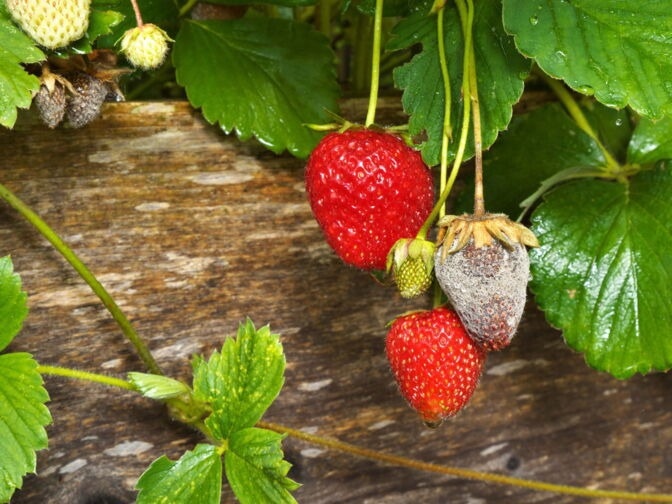Pseudomonas bacteria produce a potent antimicrobial natural product, according to scientists at the Leibniz Institute for Natural Product Research and Infection Biology (Leibniz-HKI). They demonstrated that the substance is effective against plant fungal diseases as well as human-pathogenic fungi. The findings were reported in the Journal of the American Chemical Society.
 Strawberries are especially susceptible to gray mold rot. Image Credit: AdobeStock
Strawberries are especially susceptible to gray mold rot. Image Credit: AdobeStock
The recently found natural product group of keanumycins in bacteria is effective against the plant pest Botrytis cinerea, which causes grey mold rot and massive crop losses every year. However, the active ingredient also hinders fungi dangerous to humans, such as Candida albicans. Earlier studies have shown that it is safe for both plant and human cells.
Keanumycins could thus be an environmentally friendly alternative to chemical pesticides, as well as an option in the fight against resistant fungi.
We have a crisis in anti-infectives. Many human-pathogenic fungi are now resistant to antimycotics—partly because they are used in large quantities in agricultural fields.”
Sebastian Götze, Study First Author and Postdoc, Leibniz Institute for Natural Product Research and Infection Biology—Hans Knöll Institute
Deadly like Keanu Reeves
The fact that the investigators have now found a new active ingredient in bacteria of the genus Pseudomonas is no coincidence.
Study Leader Pierre Stallforth states, “We have been working with pseudomonads for some time and know that many of these bacterial species are very toxic to amoebae, which feed on bacteria.” Pierre Stallforth is the head of the department of Paleobiotechnology at Leibniz-HKI and a Professor of Bioorganic Chemistry and Paleobiotechnology at Friedrich Schiller University in Jena.
It appears that many toxins, of which only one was previously identified, are responsible for the bacteria’s lethal effect. The researchers discovered biosynthesis genes for the newly discovered natural products, keanumycins A, B, and C, in the bacteria’s genome. This natural product category includes nonribosomal lipopeptides with soap-like properties.
The researchers were successful in separating one of the keanumycins and performing further tests with co-workers at the Bio Pilot Plant of the Leibniz-HKI.
The lipopeptides kill so efficiently that we named them after Keanu Reeves because he, too, is extremely deadly in his roles.”
Sebastian Götze, Study First Author and Postdoc, Leibniz Institute for Natural Product Research and Infection Biology—Hans Knöll Institute
The investigators assumed that keanumycins could also destroy fungi, which resemble amoebas in some ways. This assumption was confirmed in collaboration with the Research Centre for Horticultural Crops at the University of Applied Sciences Erfurt.
Keanumycin was found to be very effective against grey mold rot on hydrangea leaves. In this case, culture fluid that no longer housed bacterial cells was enough to significantly prevent fungus growth.
Theoretically, the keanumycin-containing supernatant from Pseudomonas cultures could be used directly for plants.”
Sebastian Götze, Study First Author and Postdoc, Leibniz Institute for Natural Product Research and Infection Biology—Hans Knöll Institute
Additional experiments will be carried out in collaboration with colleagues in Erfurt. Because keanumycin is biodegradable, no long-lasting residues should form in the soil. This means that the natural product can be a safer alternative to chemical pesticides.
Every year, fungal diseases like Botrytis cinerea, which causes grey mold rot, cause enormous harvest losses in fruit and vegetable cultivation. Strawberries and unripe grapes are among the more than 200 fruit and vegetable varieties affected.
Possible applications in humans
Götze notes, “In addition, we tested the isolated substance against various fungi that infect humans. We found that it strongly inhibits the pathogenic fungus Candida albicans, among others.”
Keanumycin can therefore be used in humans instead of plants. According to preliminary testing, the natural product is not highly toxic to human cells and is already efficacious against fungi at extremely low concentrations. As a result, it is an ideal candidate for the pharmaceutical development of new antimycotics. These are also desperately needed, as there are very few drugs available to treat fungal infections.
Source:
Journal reference:
Götze, S., et al. (2023) Ecological Niche-Inspired Genome Mining Leads to the Discovery of Crop-Protecting Nonribosomal Lipopeptides Featuring a Transient Amino Acid Building Block. Journal of the American Chemical Society. doi.org/10.1021/jacs.2c11107.